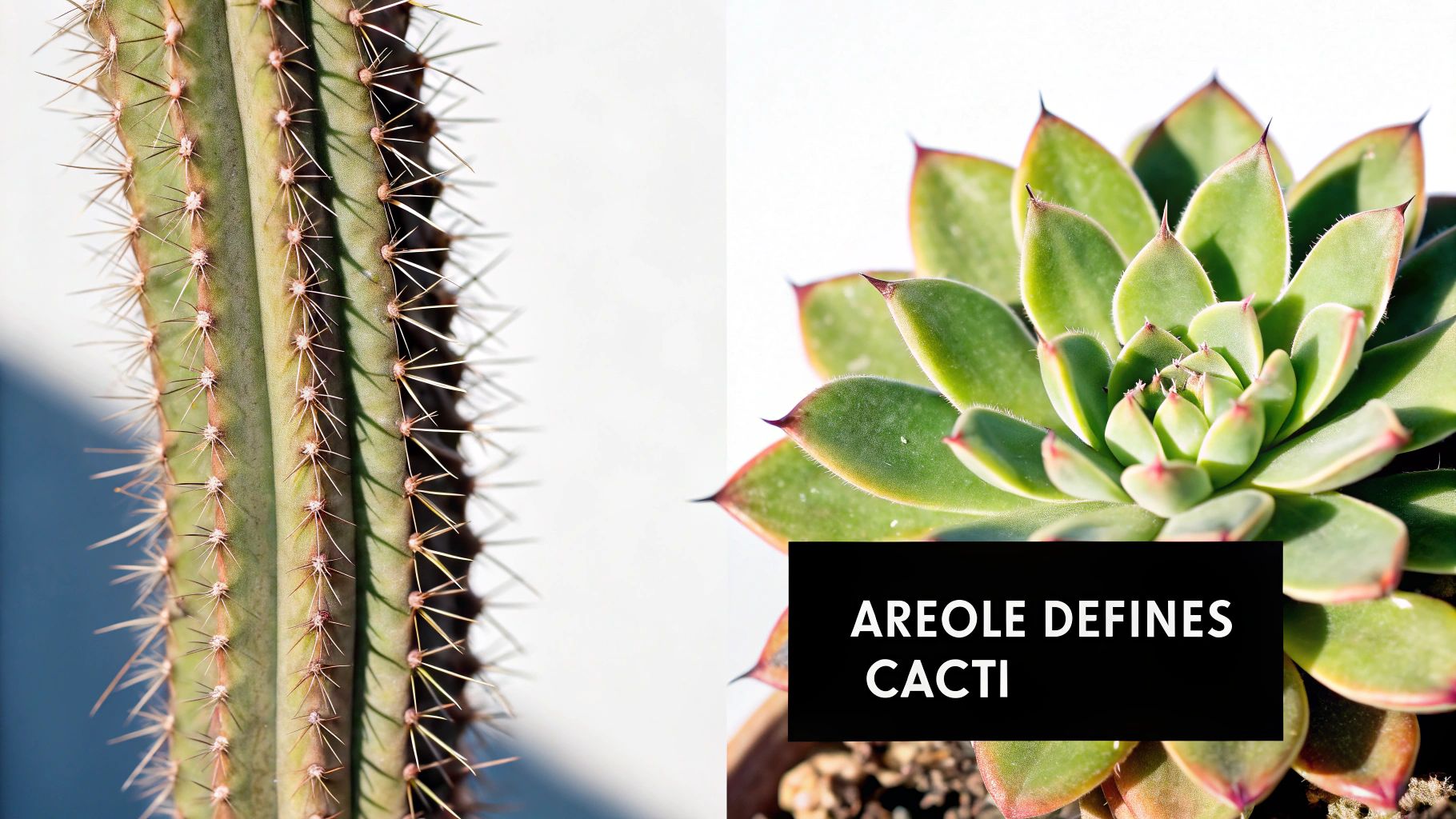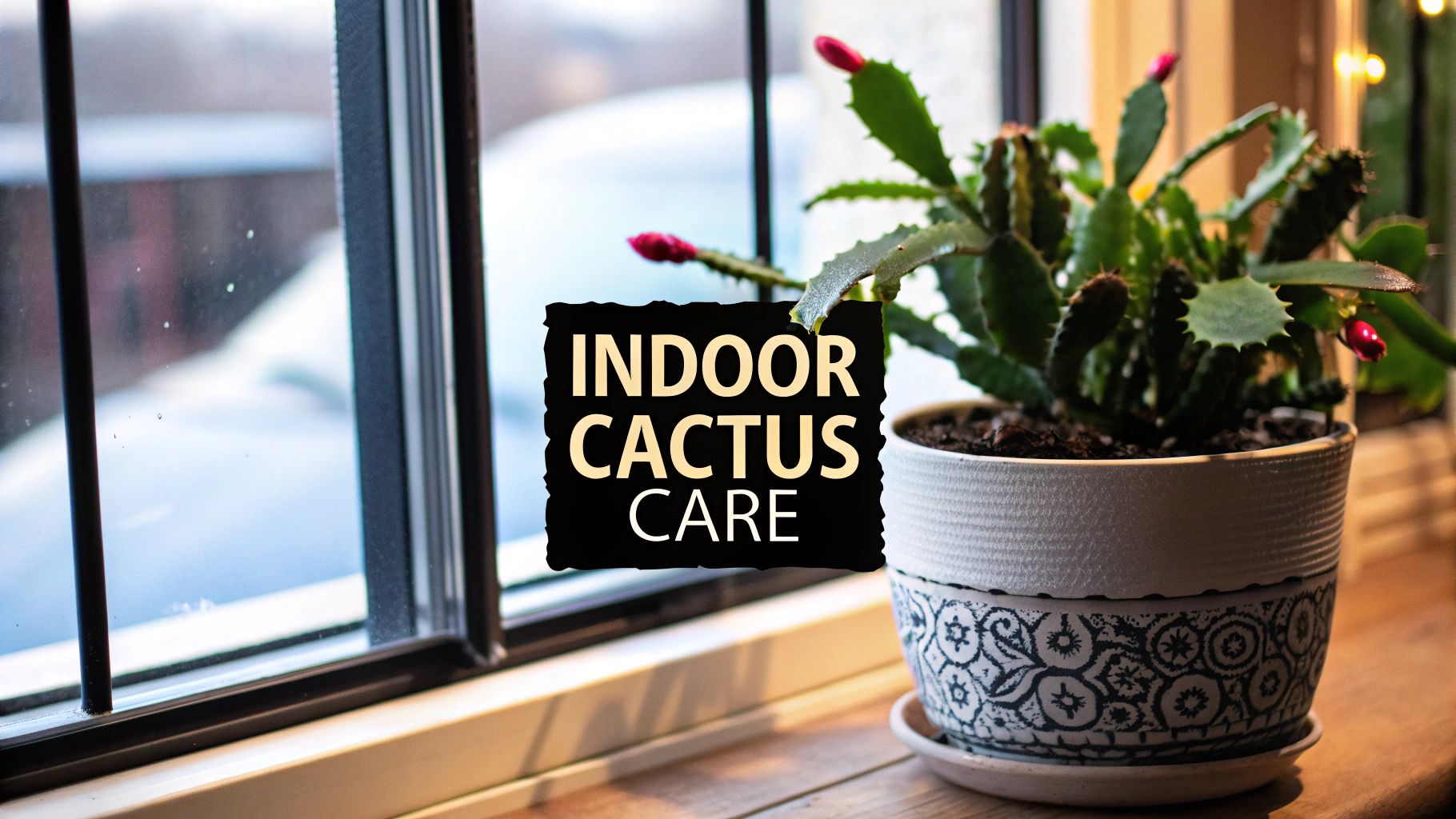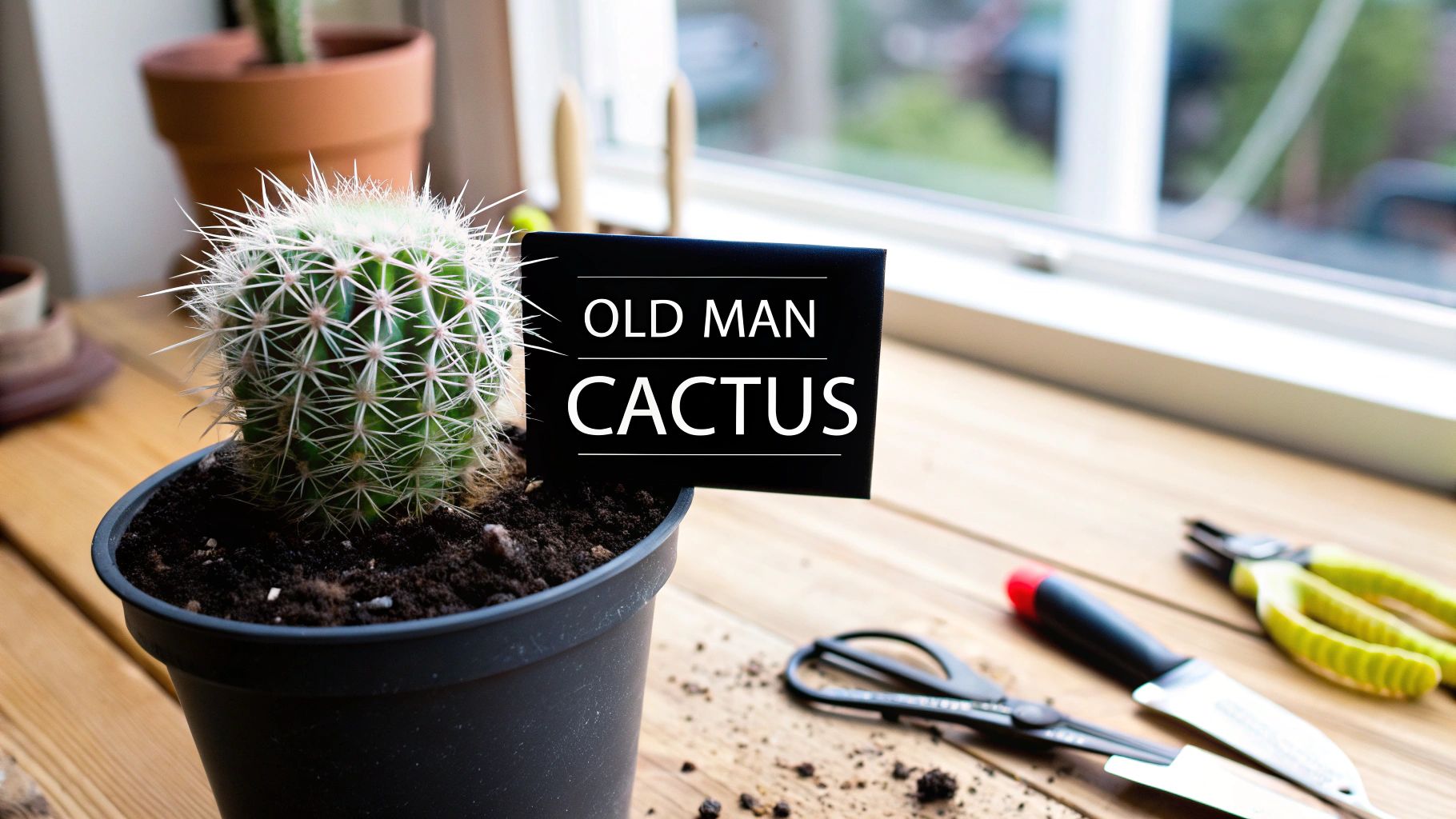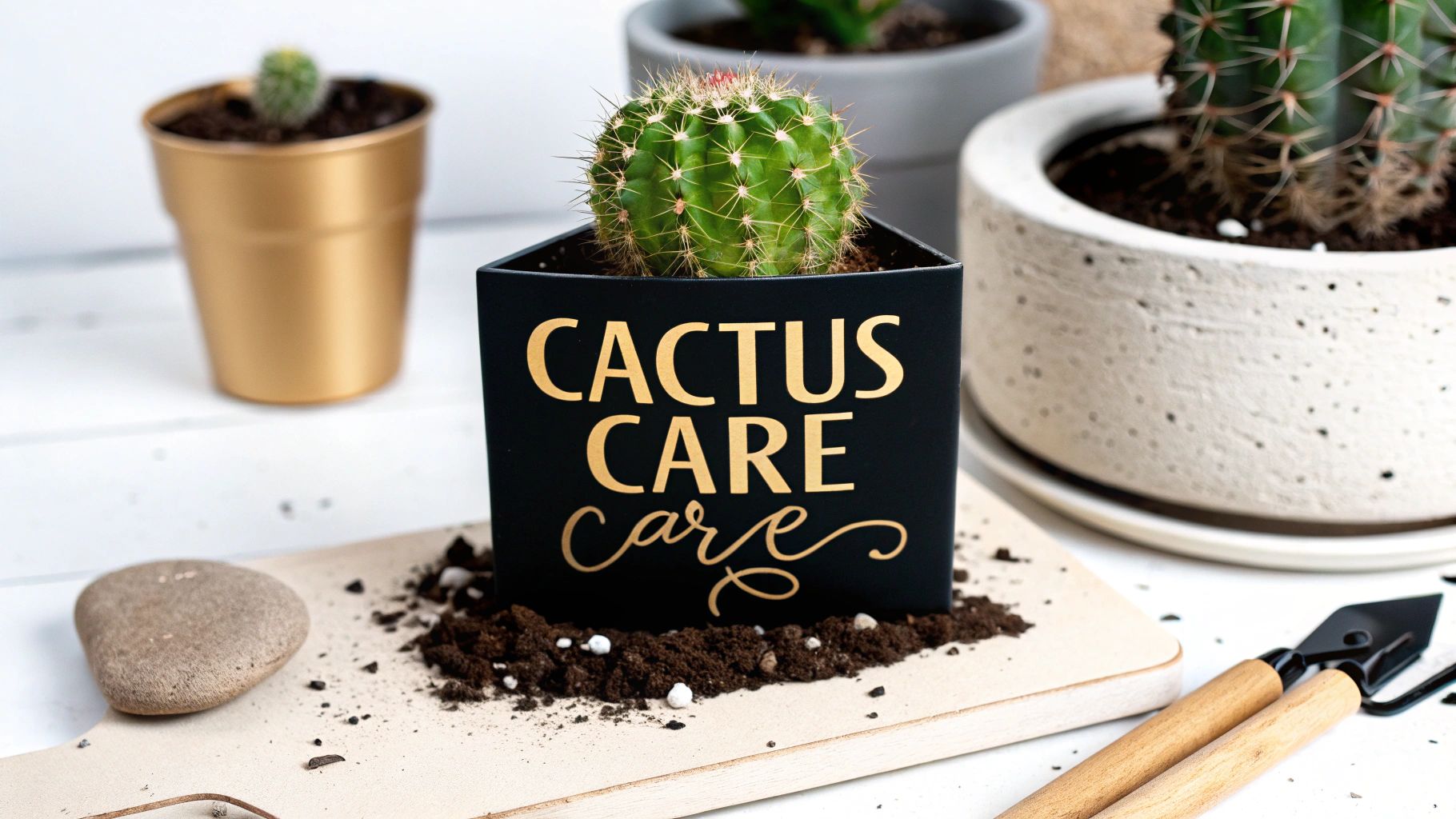It's one of the most common mix-ups in the plant world, but the difference between a cactus and a succulent is surprisingly simple: all cacti are succulents, but not all succulents are cacti.
The real distinction boils down to a single, unique feature that only cacti have: the areole.
So, What's a Succulent?
First, let's clear something up. "Succulent" isn't a scientific plant family—it's more of a description. It refers to any plant that has evolved to store water in its fleshy leaves, stems, or roots. This clever survival tactic is found in over 60 different plant families across the globe.
Think of "succulent" as an adjective, just like you'd use "tall" or "leafy" to describe a plant's characteristic.
And What Makes a Cactus a Cactus?
Now, a cactus is much more specific. It belongs to just one botanical family: Cactaceae. This exclusive club includes over 1,750 species, nearly all of which are native to the Americas.
What truly sets every single member of the Cactaceae family apart is the presence of areoles.
Areoles are small, fuzzy, cushion-like bumps on the surface of a cactus. They are highly specialized structures from which all spines, flowers, and new branches (or "pups") grow. No other type of succulent has them.
This one feature is the botanical dividing line. Even other spiky plants that look strikingly similar to cacti, like certain Euphorbias, don't have areoles. If you're curious about these doppelgängers, it's worth exploring the key differences between Cacti and Euphorbia.

To make it even clearer, here’s a quick breakdown of the most important distinctions.
At-a-Glance Cactus vs Succulent Traits
| Feature | Cactus | Other Succulents |
|---|---|---|
| Defining Trait | Always has areoles (the fuzzy spots where spines/flowers grow). | Never has areoles. |
| Plant Classification | A single plant family (Cactaceae). | A broad descriptive category covering 60+ plant families. |
| Growth Origin | Spines, flowers, and branches all sprout from areoles. | Growth emerges from various points, like nodes or stems. |
Ultimately, that little fuzzy spot is your best clue. If you can find an areole, you're definitely looking at a cactus. If not, it's one of the thousands of other fascinating succulents out there.
A Deeper Look at Structure and Survival
Beyond the areole, cacti and other succulents have entirely different blueprints for survival, shaped by millions of years in harsh climates. The most telling difference is often where they keep their water reserves, a decision that dictates their entire form, from shape to defensive measures.
Think of most cacti as living water barrels. Their iconic ribbed, columnar, or round stems are essentially accordions, built to expand dramatically after a desert downpour and slowly shrink as they use that stored water. This "stem-succulence" is a signature trait of the Cactaceae family.
In contrast, many of the succulents we know and love, like Echeveria or Sedum, take a different approach. They use their leaves as individual, fleshy water tanks. This "leaf-succulence" is what gives them those plump, often rosette-shaped forms.
How They Defend and Protect Themselves
Their protective strategies are just as different. Cacti are famous for their spines, but these aren't just for keeping predators away. Spines create a thin blanket of still air around the cactus, shielding it from drying winds and offering a bit of shade to protect its skin from the scorching sun.
Other succulents had to get more creative. Lacking spines, they developed their own unique survival toolkit:
- Waxy Coatings: Ever notice that powdery film on an Echeveria? That’s called farina. This waxy coating acts like a natural sunblock, reflecting harsh sunlight and sealing moisture inside the leaves.
- Clever Camouflage: Some plants, like the incredible Lithops (often called "Living Stones"), have mastered the art of blending in with the surrounding pebbles to avoid becoming a meal.
- Going Underground: To escape the sun and heat, certain species grow almost entirely underground, with only the very tips of their leaves peeking out.
These wildly different approaches show the separate evolutionary paths these plants took. While they all mastered the art of water storage, cacti specialized in a stem-based survival kit. The rest of the succulent world, however, shows a much broader and more diverse range of techniques. This incredible ability to retain water—with some species having up to 90–95% water content in their fleshy parts—is their ultimate key to survival. You can read more about these fascinating water retention insights to see just how well-adapted they are.
A Closer Look at Care: Light, Water, and Soil

Figuring out the differences in cactus and succulent care is the secret to helping them flourish. While both are famously drought-tolerant, their needs for light, water, and soil can be surprisingly different, shaped by where they originally grew and how they're built. Nailing these three elements is what makes or breaks a healthy plant collection.
Most cacti are native to the sun-scorched deserts of the Americas, so they’re true sun-worshippers. They crave several hours of intense, direct sunlight every day, making a south-facing window the perfect spot for them indoors. Without that powerful light, a cactus might stretch out and turn pale—a process called etiolation.
But this is where many popular non-cactus succulents part ways.
While some, like many Echeveria varieties, also love bright sun, others such as Haworthia and Gasteria thrive in bright, indirect light. Placing them in the same harsh sun a cactus adores can quickly scorch their leaves.
Watering and Soil: It's a Balancing Act
The watering schedule also tells a tale of two different plants. Cacti store the bulk of their water in their thick, fleshy stems and have a relatively low surface area, meaning they lose water very slowly. This adaptation allows them to go for long stretches between drinks, mimicking the rare, heavy downpours of their desert homes.
Leafy succulents, on the other hand, have a lot more surface area across all their leaves, causing them to lose moisture more quickly. As a result, they often need water a bit more frequently than a cactus, but the golden rule still applies: always let the soil dry out completely between waterings.
This brings us to the soil itself. Cacti need a gritty, extremely porous mix that drains in a flash to keep their roots from rotting. Think of a sandy, rocky soil with very little organic material. While other succulents also need well-draining soil, many appreciate a blend with slightly more organic matter to hold onto a tiny bit of moisture for their finer roots. Getting this foundation right is critical, and this guide on cactus and succulent soil can show you how to create the perfect mix.
Spotting the Difference: Popular Cacti and Succulents in the Wild
The best way to really get the hang of telling cacti and succulents apart is to see them in person. Let's walk through a few common examples you're almost guaranteed to find at your local nursery, so you can start identifying them with confidence.
Telltale Signs of Common Cacti
When you’re trying to ID a cactus, your first move should always be to look for the areoles—those little fuzzy bumps where the spines and flowers grow.
- Barrel Cactus (Ferocactus): You can't miss this one. It’s the quintessential desert cactus, shaped like a sturdy cylinder or ball with deep ribs running down its sides. Look closely at those ribs, and you'll see the areoles lined up perfectly, each one bristling with a cluster of intimidating spines.
- Prickly Pear (Opuntia): This cactus is famous for its flat, paddle-shaped segments (called cladodes). Its areoles are scattered across the paddles and are a double threat: they produce both the big, obvious spines and tiny, almost invisible hair-like spines called glochids. Trust me, you don't want to get those in your skin.
No matter what it looks like—tall and skinny, short and round, or flat like a pancake—if it has areoles, it's a cactus. That's the one non-negotiable rule.
Telltale Signs of Common Succulents
When you shift your focus to other succulents, you’ll notice they store water in their leaves or stems, but you won't find any areoles.
The plants pictured above show just how different succulents can be, from perfect little rosettes to long, trailing stems. What they all share is a reliance on their plump leaves for storing water.
- Aloe Vera: Everyone knows this one for its soothing gel. Aloe Vera is defined by its thick, fleshy leaves that are often serrated along the edges and grow outward from a central point. Any new growth or flower stalks come straight from the middle—no areoles involved.
- Jade Plant (Crassula ovata): This one often gets called a "money tree" and really does look like a miniature tree with its thick, woody stem and glossy, oval-shaped leaves. It's a classic succulent with absolutely no spines or areoles.
- Echeveria: These are the superstars of the succulent world, known for their stunning rosette shapes that look like little stone roses. Their beauty comes from the tight arrangement of their colorful, fleshy leaves.
Once you start spotting these key features, telling these plants apart becomes second nature. If you're ready to explore even more, this guide to the different types of succulents and cacti is a great next step.
Choosing the Right Plant for Your Space
Picking the perfect plant is about more than just what looks good on the shelf. It’s really about matching a plant’s ancient survival toolkit to your home’s environment and, just as importantly, your own lifestyle. The core differences in how cacti and succulents evolved to handle stress are your best clues for making the right choice. Once you get that, you stop guessing and start knowing what will actually thrive.
First thing's first: look at your light. Got a window that gets absolutely baked in direct sun for six or more hours a day? That’s prime real estate for a true desert cactus. Something like a Golden Barrel Cactus or a classic Prickly Pear will feel right at home in that intense sunlight, which would scorch most other houseplants.
But what if your space is bright without being a furnace? Maybe you have a spot near an east-facing window that gets gentle morning sun. That's where a leafy succulent like a Haworthia or Jade Plant will be much happier, as harsh, direct light can burn its leaves.
This little decision tree can help you sort through the main questions when you're at the nursery trying to decide.

As the chart shows, finding those tell-tale areoles is the fastest way to confirm you’re looking at a true cactus.
Matching a Plant to Your Lifestyle
How you live your life is just as critical as the sunlight in your home. Are you always on the go, or do you sometimes just forget to water things? Be honest.
If you’re a hands-off plant parent, a cactus is your new best friend. Its entire body is basically a giant water tank, meaning it can go for weeks without a drink, just like it would in the desert waiting for a rare downpour.
On the other hand, maybe you enjoy the process of checking in on your plants and getting your hands a little dirty. Leafy succulents tend to give you clearer signals when they're thirsty. A Jade Plant's leaves, for instance, will get a little soft or wrinkly when it’s time for water, making the whole experience feel more interactive.
In the end, it also boils down to pure aesthetics. Are you drawn to the bold, sculptural, almost minimalist vibe of a cactus? Or do you prefer the softer, geometric patterns and vibrant colors of an Echeveria rosette? When you line up your space, your habits, and your personal style with a plant’s built-in needs, you've found a perfect match.
Why Is Everyone Suddenly Obsessed with These Plants?
https://www.youtube.com/embed/bsCLBpaJ2jA
The massive popularity of cacti and succulents isn't just some passing fad—it's a full-blown horticultural movement perfectly suited to modern life. Their famous low-maintenance attitude makes them ideal for anyone with a packed schedule or those just dipping their toes into plant ownership. It's this easy-going nature that has welcomed a whole new generation into the world of houseplants.
But it’s not just about easy care. These plants have become a cornerstone of interior design, especially with the rise of the biophilic decor trend. This whole design philosophy is about weaving natural elements into our indoor spaces to improve our well-being and create a more serene environment. The wild, sculptural shapes and unique textures of cacti and succulents make them feel more like living art than just another plant on a shelf.
This shift from a niche hobby to a mainstream obsession really points to something deeper—a genuine desire to reconnect with the natural world, even from inside our homes.
And this isn't just a feeling; the numbers back it up. The global market for these plants hit an incredible USD 14.24 billion in 2023. Even more impressive, it's expected to nearly double by 2032, proving just how deeply this green obsession has taken root. You can explore the full succulent and cactus market report to see the data driving this boom for yourself.
Still Have Questions? Let's Clear Things Up
Even after you've got the basics down, a few questions always seem to come up. It's completely normal. Let's tackle some of the most common ones so you can feel totally confident in your plant choices.
So, Are All Succulents Desert Plants?
Not at all—and this is probably the biggest myth out there! While it's true many succulents (especially cacti) thrive in deserts, that water-storing trick is handy in a lot of different climates.
Think about it: the ability to hold onto water is a great survival skill for any environment with a dry season. You'll find succulents native to coastal regions, high alpine slopes, and even tropical rainforests. The popular Christmas Cactus, for example, is a tropical native that grows on trees, not in the sand.
The word 'succulent' is just a description of a feature—storing water. It's a strategy for surviving dryness, wherever that may occur, not a sign that the plant comes from a desert.
Can I Plant Cacti and Other Succulents Together?
You absolutely can, but you have to be smart about it. The golden rule for any mixed planter is to group plants that want the same things. It's all about matching their care needs.
If you stick a sun-worshipping desert cactus next to a succulent that prefers a bit of shade, one of them is going to be miserable. Before you combine them in one pot, always do a little homework on the specific light and water requirements for each plant you've chosen.
What's the Dead Giveaway That My Plant Is a Cactus?
Look for the areoles. This is the one foolproof trick. Areoles are the small, fuzzy, cushion-like bumps on a cactus's body.
Every single spine, flower, and new branch grows directly from one of these spots. You might see other spiky succulents that look a lot like cacti, such as some types of Euphorbia, but they won't have areoles. If you can spot those little fuzzy dots, you've got yourself a true cactus.
Ready to find the perfect plant for your space? Explore a huge selection of authentic cacti and beautiful succulents at The Cactus Outlet and get a stunning, healthy plant delivered right to your door. Start browsing the collection at https://www.cactusoutlet.com.




